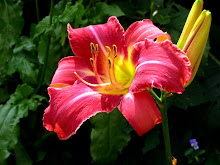
One of my favorite books on ADD is Attention Deficit Disorder: A Different Perspective by Thom Hartmann (bear with me -- I promise this will relate to farming and growing!). His point of view can be boiled down to this: it's Hunter vs. Farmer. That in evolutionary terms, looking at the development of humans over the millenia, being a "Hunter" -- someone whose senses are keen enough to be easily distracted by/tuned into any change in the environment, who can think quickly and make fast changes without having to think something through carefully, thriving on the excitement of the hunt -- meant being a survivor. That today's world, however, is set up for the "Farmer" -- one who can be comfortable with routine, repetitive tasks, sit still when asked, work incrementally towards distant goals with self-discipline. Someone who can cope with disastrous weather, an infestation of bugs, deer breaking through the fence ruining their crops, and is willing to try again next year.
I'm probably not characterizing this very well; if you're interested, check out his book at Amazon (or better yet, your friendly local bookstore.)
But I am, for lack of a better description, an ADD Farmer. An oxymoron, if you will. I have all the characteristics of ADD that can be found listed in the hundreds of books on the subject. And yet I'm passionate about growing, something that requires forethought, planning, many repetitive mundane tasks, and patience. My ability to summon forth those qualities varies wildly from day to day, month to month, year to year. I repeat a lot of mistakes. I get impatient and plant too early, or forget and plant too late. I grow weary of weeding and in short measure, a jungle grows. I forget to close up the greenhouse on a cold night. I go out to plant potatoes, get distracted by the daylilies, and the potatoes must wait for another day. Sometimes I just sit in the field for a long while and drink in the perfectly blue sky, the cottony clouds, the hawks circling overhead, the wind sighing through the pine forest.
This is why, of course, I'm not really cut out to be someone who makes a living at farming. Not enough organization and discipline. It's extraordinarily hard work as well; for several years we grew veggies, herbs, and flowers for market. We worked from early in the morning until sunset; we worked on hot, humid summer days and in the cold, wet spring and fall; we battled black flies and deer flies and mosquitoes, potato beetles, underground voles, and learned not to let the chickens run free when the tomatoes were ripe. There was a point during each summer when I thought, why do I spend my summers this way? This is just too much. I'm not doing this any more.
But the rewards! -- the excitement of the seeds sprouting through the earth each spring; perennials peeking through the early spring snows; the taste of fresh peas and green beans, ripe tomatoes warmed by the sun, rich buttery garlic and fresh basil made into pesto, a tea of homegrown chamomile and lemon balm. The miracle of so many flowers, not only those we grow simply for their beauty, but those whose purpose is to attract the pollinators and will transform into cucumber, squash, melon, strawberry. The lushness of the flower beds at the peak of bloom. To work in a garden and a field of crops is to be surrounded by the miracle of life, expressing itself in ways that delight all the senses. Even the occasional sightings of deer, of bear, of a flock of turkeys, takes my breath away.
And so now it begins all over again, with the seeds emerging from their pots. The particular fun of growing daylily seeds is that each one will produce a flower never seen before, a new combination of genetic code -- like opening a gift, not knowing what's inside. It requires patience: they will not flower until the second year this far north, at the earliest. It requires the willingness to be disappointed: many will be only so-so, destined for the compost pile. But during the blooming season, as soon as the sun comes up, this ADD Farmer cannot stay in bed nor in the house: it's up and out to hunt for the newest daylily, to see what may have bloomed, to gather greens for the day, to revel in the beauty of the early-morning gardens.
Somehow it all works. Imperfectly, of course, but isn't that life?



